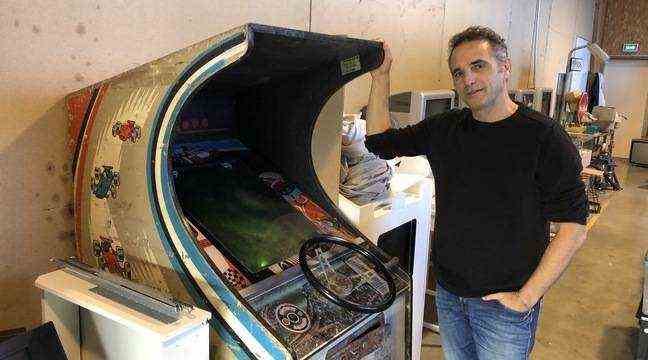“Computing, digital technology has changed our civilization in 60 years and yet there is no museum although we have it for everything, including carrots and lightning, it still seems crazy! », Indignant Olivier Boisseau, computer engineer and founder of
Replay Museum. The Gironde association is carrying out the project of a permanent exhibition space for digital heritage. Thousands of pieces, some of which are very rare, are stored in a warehouse in Martillac, in the Gironde, but they are in danger. The health crisis has prevented the holding of exhibitions which allow the association to live on at the time, to safeguard these collections and consider a future museum,
she launched a pot. She is also urgently looking for a new storage location for the start of the year.
It’s a sea of computers, consoles, CRT screens, arcade machines and computer accessories that come into view when you step into the warehouse at Replay Museum. On the one hand the first car arcade game, which dates back to 1976, with an unusual rounded design and rusty steering wheel, a little further on is an arcade machine from 1969 which is electromechanical. “Inside, these are kinds of bicycle chains that turn a decor on a drum, with lamps behind and the road is displayed on the screen by a set of mirrors, it’s very ingenious”, s marvels Olivier Boisseau. A collector, he began to hunt for pieces in the 1990s and 2000s. “At the time we collected everything for nothing,” he summarizes. At the end of the 1990s, this computer enthusiast designed a dedicated site, called oldcomputers.com, which still exists.
Rare pieces
We walk past a giant (functional) Game Boy created for exhibitions, before arriving in front of one of the rarest pieces: the first Magnavox Odyssey 1972 video game console. accessories are necessary: cards, dollars, tokens but also plastic decorations which are fixed on the TV screen thanks to static electricity. And beware, the computer cannot detect who is cheating or winning the round so you have to watch your opponent. For example, there is a game of cat and mouse in a maze. “It’s ten years before Packman,” recalls Olivier Boisseau. Nothing else existed at that time! »Another treasure of the collection: the first personal computer, from Olivetti. It dates back to 1965 and has no screen: all outputs are done on a small roll of paper.
Small cocorico in front of the Micral because the first microcomputer, that is to say the first personal computer to use a microprocessor, is French. “There are five in the world, it’s a very rare piece,” comments Olivier Boisseau. It is a source of pride and it has its place in a museum. While the United States and England were ahead at this time, it was created by a French engineer and a French company. “
A cultural project
The idea is to offer a real cultural mediation on the history of computing and not just to “put machines on tables”, emphasizes Olivier Boisseau. On the Minitel for example, he explains that the old-fashioned image that sticks to his skin in retrospect is not justified. “By reinserting it into history, we understand that it was a French innovation in the appearance of planetary networks,” points out the founder of Musee Replay. And to make it fun, we can imagine reconnecting Minitels to servers for example ”. The association is repairing the devices it recovers and about half of the parts stored are functional.
Beyond the nostalgia attached to any collection, it can be used for playful mediation, highlights the founder of Musée replay. Older visitors often show their children the games they were playing and they end up having a game. For a game console, the association believes that it is necessary to let two generations pass to talk about retrogaming. The Play Station 3 is already part of it and “we will buy a PS5 in 15 years”, hopes Olivier Boisseau, who firmly believes in this project of a first digital museum.

